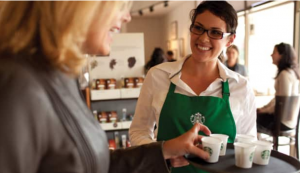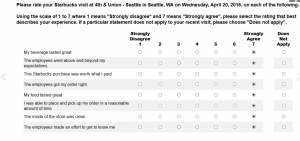In high school, I found myself asking the same question as my peer, Prakruti, why is Starbucks so successful? The drinks were delightful, but product simply isn’t enough for any business to expand to this size.
My curiosity ultimately led me to submit a resume to a local Starbucks store, and though I was only a barista, I had a peak into the organizational structure of Starbucks that was systematic and efficient. Management goes from a shift supervisor making sure a barista performs cycle tasks on time, to a district manager, coming in to inspect for cleanliness. And while I strongly agree with Prakruti that employees are highly valued in Starbucks (there were additional benefits, such as a free pound of coffee a week), the company’s ability to retain and grow customer loyalty is its most critical feature in distinguishing itself from other coffee chains–its points of difference. The idea that the “customer is god” deeply rooted in Starbucks culture. However, this slogan only sets the bottom line for how customers should be treated. It’s not just about customers being right. Greeting consistent customers by their name, learning names of new customers, having small talks, or even just simple grin and a “thank you, have a great day,” are encouraged to manifest a sense of attachment in the customer. Starbucks keeps their source of profit close to them.

The Starbucks’ Star Rewards program sends emails about promotions to members to help them earn stars faster, which means shorter time to a free food or drink once they collect 125 stars. And though Starbucks could profit from higher traffic if they were to lower the price of their drinks, Starbucks chooses to uphold its own reputation and “treat” their customers to free drinks. This concept of “free” is much more powerful in the mind of a customer than say, a cheaper cup of coffee.
The company also stays in check with its customers’ experience at Starbucks stores. A survey will automatically be emailed to the customer’s registered email if they paid with an activated Starbucks card. The survey is like Starbucks’ own primary market research, in which they ask customers to rate their experience at Starbucks from a scale of 1 to 10. Upon completion of the survey, Starbucks awards the survey taker with bonus stars, a token of gratitude for the customer’s time.

And while other coffee stores around have been copying this form of operation that Starbucks practices, I do find myself biasing Starbucks more, because Starbucks was indeed the first coffee company that implemented such a sophisticated, well thought out loyalty program, and gained widespread popularity. Because they are first in the mind of many customers, Starbucks is irreplaceable.
Word count: 449

One response to “Starbucks: Keep Your Friends Close, and Your Customers Closer.”